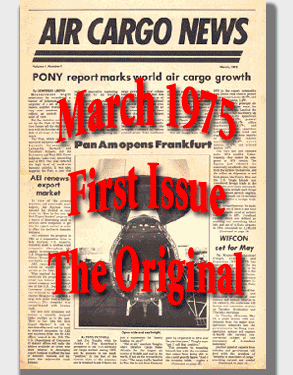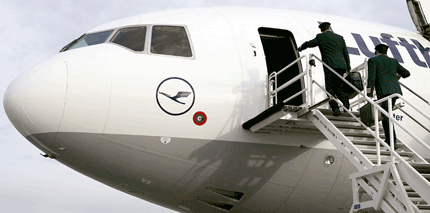|
|
 |
|
 |
 Cathay
Pacific Airways cancels an order for eight
Boeing 777-200F freighters due to slowing
demand but has signed an agreement to buy three Boeing
747-8 freighter aircraft .
. . Cathay
Pacific Airways cancels an order for eight
Boeing 777-200F freighters due to slowing
demand but has signed an agreement to buy three Boeing
747-8 freighter aircraft .
. .Lufthansa Cargo added Wed/Sat freighter services to Guadalajara via Chicago from Frankfurt March 2, to return Thurs/Sun . . . Bellies Up… Saudia Cargo said it moved 12,242 tons of cargo in its passenger aircraft bellies ex-Dubai during 2012, as the second busiest combination cargo carrier operating out of the Emirates . . . SAS signs letter of intent to turn all ground handling activities in Denmark, Sweden and Norway to Swissport . . . Mariners have dreamed of shipping the Northwest Passage across the North Pole via a sea route from Newfoundland toward the Bering Strait, neither of which has ever been done. Now a USA study in The Proceedings of the National Academy of Sciences suggests that global warming is opening up a route that could deliver huge savings in time and money for shippers, as traversing the North Pole could be done in 14.6 days. NOAA plans to issue new maps. Stay tuned . . . Sri Lanka starts storing bunker fuel at the $1.5 billion Hambantota port in June, after years of delays to the Chinese-built installation that sits on strategic shipping lanes . . . Second Sri Lanka International Air Freight, Shipping & Logistics Expo 2013 at Sri Lanka Exhibition & Convention Centre closed Sunday as Colombo’s new Hambantota International Airport readies its March 18 opening . . . In the USA, Forward Air Corp. acquired Total Quality, a Michigan-based trucker specializing in temperature-controlled services to the pharmaceutical and life science industries . . . Starting this month, China Eastern Airlines & Air China said it would no longer ship primates to laboratories to be used in experiments. People For The Ethical Treatment of Animals (PETA) said, “during 2012, more than 10,000 primates were air shipped into the USA from China for experiments” . . . In the USA, just days after the official enactment of blind and across-the-board spending cuts known as the sequester, lines at some major airports are already doubling, Homeland Security Secretary Janet Napolitano told reporters. Meantime, FAA could begin furloughing air traffic controllers in early April because of $627 million in automatic spending cuts. The plan is to eliminate the midnight shift in more than 60 control towers and close more than 100 towers at smaller airports . . . United Cargo now accepts two additional tracking and monitoring devices on its entire mainline jet fleet: The Moog Crossbow ILC2000 and the FedEx SenseAware 2000 . . . After spending $600 million over two years with the help of loans and workers from China to rebuild the two main rail lines out of the capital, this month Angola (Africa’s second largest oil producer) moves the first of what could be 615,000 metric tons of cargo yearly from the port of Luanda. The cargo moves along a refurbished rail line from the capital to the city of Malange, and from the Boa Vista cargo terminal near the port to Viana, a location with special economic zone status to encourage industry . . . DHL Global Forwarding U.S. Customer Service Team has been selected as the winner of the 7th Annual Stevie® Awards for Sales & Customer Service Training Team of the Year at a banquet and ceremony in Las Vegas, Nevada, on Feb. 25 . . . “Air cargo up 4.5 percent in January, as Asia and Middle East pace growth,” IATA said on Monday. Numbers still below two years ago, but stabilization may be taking hold . . . Lawmakers in Australia are looking for $38.8 million to get a roll-on, roll-off shipping service operating a weekly freight service from Bell Bay to Brisbane, as solution to end Tasmania’s export freight woes. “Tasmanian Mariner,” could also serve as a training vessel to provide sea time for Australian and overseas maritime students . . . European Commission has moved deadline for its known shipper rule, a new security law for shippers using air cargo out of Europe, from March 25 to April 29 . . . Kuehne + Nagel Group reported 2012 increased volumes in all business units despite slower international trade growth. Declining profit margins, cost increases and an antitrust fine of CHF 65 million imposed by the European Commission drive a “slightly reduced “dividend of CHF 3.50 per share. For the year turnover increased by 5.9 per cent to CHF 20,753 million and gross profit improved by 3.3 per cent to CHF 6,094 million . . . With accolades for his service, Kuehne + Nagel Group said, CEO Reinhard Lange will step down May 7, 2009, due to health reasons. A management team under the leadership of Karl Gernandt, Chairman of Kuehne + Nagel International AG, takes over whilst seeking Lange’s successor . . . |
Get
On Board Air Cargo News FlyingTypers |
If
You Missed Any Of The Previous 3 Issues Of FlyingTypers
|
|||||
|
|||||
FT022113 |
FT030413 |
||||
|---|---|---|---|---|---|





 “That
does not, of course, mean that we are not investing
in our route network. Last year, for example, we brought
Tel Aviv and Detroit into our freighter schedules as
new destinations.
“That
does not, of course, mean that we are not investing
in our route network. Last year, for example, we brought
Tel Aviv and Detroit into our freighter schedules as
new destinations. 






